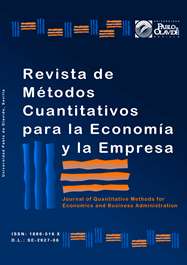Redes, conocimientos y capacidades en el contexto de la industria del software. Análisis del caso Bahía Blanca
DOI:
https://doi.org/10.46661/revmetodoscuanteconempresa.5915Palabras clave:
redes, conocimientos, capacidades, software, Bahía BlancaResumen
En las últimas décadas ha surgido a nivel mundial un creciente interés por los fundamentos micro y meso económicos de la competitividad. Diversos autores han diseñado enfoques que buscan explicar este fenómeno a partir del desarrollo de capacidades endógenas y relacionales por parte de las empresas. Las capacidades relacionales se ejercitan en contacto con otros agentes y permiten explotar adecuadamente los conocimientos y recursos que circulan por el ámbito de las redes. El presente trabajo analiza este tipo de competencias y los vínculos que existen entre las empresas de software de la ciudad de Bahía Blanca. La metodología utilizada para el estudio de este fenómeno es el análisis de redes sociales o ARS.
Descargas
Citas
Bastanchury-López, M.T., De-Pablos-Heredero, C., Montes-Botella, J.L., Martín-Romo- Romero, S., & García, A. (2020). Impact of dynamic capabilities on performance in dairy sheep farms in Spain. Sustainability, 12(8), 3368.
Becattini, G. (Ed.). (1989). Modelli locali di sviluppo (p. 231). Bologna: Il Mulino.
Borgatti, S.P. (2002). NetDraw: Graph visualization software. Cambridge, MA: Analytic Technologies.
Borgatti, S.P., Everett, M.G., & Freeman, L.C. (2002). Ucinet for Windows: Software for social network analysis. Harvard Analytic Technologies, 6, 12-15.
Borgatti, S.P., Mehra, A., Brass, D.J., & Labianca, G. (2009). Network analysis in the social sciences. Science, 323(5916), 892-895.
Boscherini, F. & Yoguel, G. (1996). La capacidad innovativa y el fortalecimiento de la competitividad de las firmas: el caso de las pymes exportadoras argentinas. (Documento de Trabajo CEPAL N° 71) Buenos Aires: Comisión Económica para América Latina y el Caribe (CEPAL).
Casas, R. (2003). Enfoque para el análisis de redes y flujos de conocimiento. En Itinerarios del conocimiento: formas dinámicas y contenido: un enfoque de redes (pp. 19-50). Anthropos.
Cohen, W.M., & Levinthal, D.A. (1990). Absorptive capacity: A new perspective on learning and innovation. Administrative science quarterly, 35(1), 128-152.
Cowan, R., David, P.A., & Foray, D. (2000). The explicit economics of knowledge codification and tacitness. Industrial and corporate change, 9(2), 211-253.
Diez, J.I. (2010). Desarrollo endógeno en Bahía Blanca: empresas, organizaciones y políticas públicas. Bahía Blanca: Ediuns.
Diez, J.I. & Pong, C. (2021). Redes institucionales y desarrollo económico en ciudades pequeñas: los casos de General Acha y Pigué. Revista Pilquén. Sección Ciencias Sociales, 24(1), 48-69.
Harrigan, K. (1992). Joint venture. Buenos Aires: Tesis-Norma.
Johnson, B., & Lundvall, B.A. (1994). Sistemas nacionales de innovación y aprendizaje institucional. Comercio exterior, 44(8), 695-704.
Lundvall, B.A. (1992). User-Producer relationships, national systems of innovation and internationalisation. En B.A. Lundvall (Ed.), National Systems of Innovation. Towards a Theory of Innovation and Interactive Learning. London: Pinter.
Marshall, A. (1919). Industry and trade. London: MacMillan.
Mertens, L. (1996). Competencia laboral: sistemas, surgimiento y modelos. Montevideo, Uruguay: Cinterfor.
Morgan, G. (1986). Imágenes de las organizaciones. México DF: Alfaomega.
Nelson, R.R. (1991). The role of firm differences in an evolutionary theory of technical advance. Science and public policy, 18(6), 347-352.
Nelson, R.R. & Winter, S. (1982). An evolutionary theory of economic change. Cambridge: The Belknap Press of Harvard University Press.
Penrose, E. (1959). The theory of the growth of the firm. Oxford: Oxford University Press.
Pereira, M., Barletta, M.F., & Suárez, D. (2015). El rol de las vinculaciones en el desarrollo de las capacidades de la firma. Un análisis de redes sociales de la industria del software en Argentina. Pymes, Innovación y Desarrollo, 3(2), 3-21.
Pisano, G., & Teece, D. (1994). The dynamic capabilities of firms: an introduction. Industrial and Corporate Change, 3(3), 537-556.
Salavisa, I., Sousa, C., & Fontes, M. (2012). Topologies of innovation networks in knowledge-intensive sectors: Sectoral differences in the access to knowledge and complementary assets through formal and informal ties. Technovation, 32(6), 380-399.
Teece, D.J., Pisano, G., & Shuen, A. (1997). Dynamic capabilities and strategic management. Strategic Management Journal, 18(7), 509-533.
Villaroel-Molina, O., De Pablos-Heredero, C., Barba, C., Rangel, J. & García, A. (2021). The Importance of Network Position in the Diffusion of Agricultural Innovations in Smallholders of Dual-Purpose Cattle in Mexico. Land, 10(4), 401.
Wasserman, S., & Faust, K. (2013). Análisis de redes sociales. Métodos y aplicaciones. Madrid: Centro de Investigaciones Sociológicas.
Wernerfelt, B. (1984). A resource‐based view of the firm. Strategic Management Journal, 5(2), 171-180.
Yoguel, G. (2000). Creación de competencias en ambientes locales y redes productivas. Revista de la
CEPAL, 71(1), 105-119.
Publicado
Cómo citar
Número
Sección
Licencia

Esta obra está bajo una licencia internacional Creative Commons Atribución-CompartirIgual 4.0.
El envío de un manuscrito a la Revista supone que el trabajo no ha sido publicado anteriormente (excepto en la forma de un abstract o como parte de una tesis), que no está bajo consideración para su publicación en ninguna otra revista o editorial y que, en caso de aceptación, los autores están conforme con la transferencia automática del copyright a la Revista para su publicación y difusión. Los autores retendrán los derechos de autor para usar y compartir su artículo con un uso personal, institucional o con fines docentes; igualmente retiene los derechos de patente, de marca registrada (en caso de que sean aplicables) o derechos morales de autor (incluyendo los datos de investigación).
Los artículos publicados en la Revista están sujetos a la licencia Creative Commons CC-BY-SA de tipo Reconocimiento-CompartirIgual. Se permite el uso comercial de la obra, reconociendo su autoría, y de las posibles obras derivadas, la distribución de las cuales se debe hacer con una licencia igual a la que regula la obra original.
Hasta el volumen 21 se ha estado empleando la versión de licencia CC-BY-SA 3.0 ES y se ha comenzado a usar la versión CC-BY-SA 4.0 desde el volumen 22.










